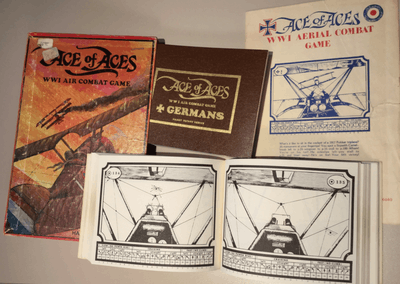Ace of Aces (picture book game)

Ace of Aces is a two-player combat picture book game designed by Alfred Leonardi and first published in 1980 by Nova Game Designs. In 1981, Ace of Aces won the Charles Roberts/Origins Gamers Choice of 1980[1] and was inducted into the Adventure Gaming Hall of Fame in 1994.[2]
In 1999, Pyramid magazine named Ace of Aces as one of the Millennium's Best Games. According to that magazine the game is "nothing more than a hex-based single-unit wargame, [but] what made Ace of Aces great was the presentation. By completely hiding the actual mechanics of the game in the flipbooks, it didn't feel like a wargame."[3]
Gameplay
Each set includes a pair of small books, one for each player (generally marked 'German' and 'Allied'). These are like gamebooks in that instead of reading through them, a person is 'at' one particular page, and the book represents a World War I fighter. Each player turns to the same page number in his book; the illustration on that page shows the view from the cockpit of his airplane, looking at the opponent. Along the bottom of the page is series of maneuvers that can be performed, with page numbers listed under them (while the page numbers are different with each page, the maneuvers are constant).
Each player selects a maneuver. Both players then announce the corresponding numbers. Each player turns to the page number announced by the opponent, looks up his own maneuver there, and turns to the page number listed under it. After both players have done this, they are on the same (new) page, looking at new views of each other. The process is repeated until one player has maneuvered his opponent into the sights of his guns and can shoot him down.
The maneuvers in both books are the same, with each set representing a range of aircraft with similar handling characteristics. Different sets are completely compatible with each other and can be used together, as long as opposing books are selected.
Additionally, a single player can in essence "fly solo" by picking up any single book and executing maneuvers. The result is not unlike using the aircraft pictured in the book's pages as a fixed, non-moving spatial reference point. This provides an easy way for newcomers to the game to get a feel for what each maneuver does, and hence a reasonably quick way to get up to a competitive level of play against opponents.
Gameplay could further be customised by using an included sheet of rules which provided for "intermediate" and "advanced" games. These games added factors such as altitude difference, ammunition supply, windspeed and jammed guns to the basic game (which assumed the guns always worked and had an endless supply of ammunition, and that the players would fly at the same altitude throughout in still air).
Despite what some perceived as a lack of "realism", the basic game was extremely popular and simple to learn, and it could be played anywhere there was room for two people to sit or stand.
Reprint Project
The game is long out of print, but in July 2012 a Kickstarter project was initiated to reprint the game, with the permission and cooperation of the game's designer. The project was successful and the game was published in January 2014.
Expansions
- Handy Rotary Series (1980)
- Powerhouse Series (1981)
- Flying Machines (1983)
- Balloon Buster (1985)
- Handy Rotary Deluxe Edition (1986)
- Wingleader (1988)
- Jet Eagles (1990)
Other games
Ace of Aces was the first game of this type, but others were done later. Bounty Hunter used much the same format for an old west gunfight (only one set was released, Shootout at the Saloon). Dragonriders of Pern used the Ace of Aces format in a contest to stop Threadfall. Alfred Leonardi also designed the Lost Worlds combat book game system which is sometimes mistakenly described as using the Ace of Aces system. Joe Dever also used this style of books in a fantasy setting for his Combat Heroes books.
In 1989, West End Games released a set of books with the title "Starfighter Battle Book: X-wing vs. Tie Interceptor", using exactly the same Ace of Aces format: even the shooting pages are the same as those in the earlier game.
References
- ↑ "Origins/Charles Roberts Award Winners (1980)". Academy of Adventure Gaming Arts & Design. Archived from the original on 2008-04-15. Retrieved 2007-10-16.
- ↑ "Origins Award Winners (1993)". Academy of Adventure Gaming Arts & Design. Archived from the original on 2007-11-06. Retrieved 2007-10-16.
- ↑ Haring, Scott D. (1999-12-24). "Second Sight: The Millennium's Best "Other" Game and The Millennium's Most Influential Person". Pyramid (online). Retrieved 2008-02-16.
External links
- Flying Buffalo's home page for the game
- Ace of Aces Collector's Guide by Joseph J. Scoleri III
- Gamebooks.org description of the game and list of available game books
- BoardGameGeek list of the games in the series
- Ace of Aces at BoardGameGeek
- Duelo de Águias, Brazilian edition, Grow, 1984